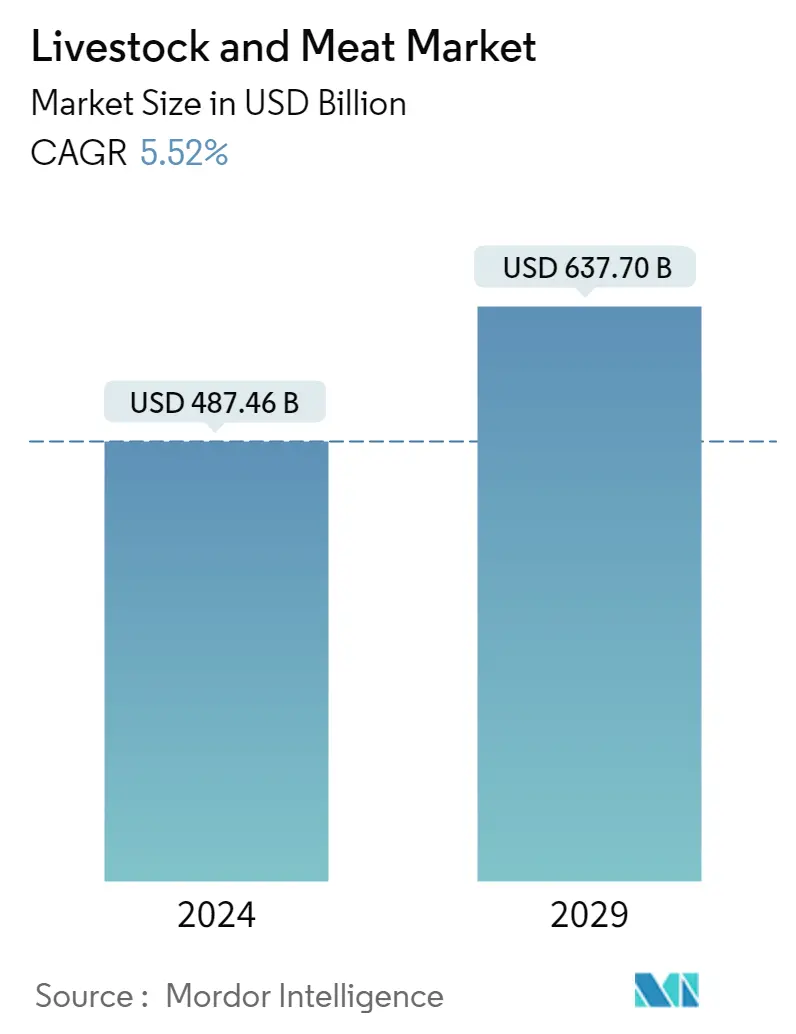Market Size of Livestock and Meat Industry

| Study Period | 2019 - 2029 |
| Market Size (2024) | USD 487.46 Billion |
| Market Size (2029) | USD 637.70 Billion |
| CAGR (2024 - 2029) | 5.52 % |
| Fastest Growing Market | Asia-Pacific |
| Largest Market | North America |
Major Players*Disclaimer: Major Players sorted in no particular order |
Livestock & Meat Market Analysis
The Livestock and Meat Market size is estimated at USD 487.46 billion in 2024, and is expected to reach USD 637.70 billion by 2029, growing at a CAGR of 5.52% during the forecast period (2024-2029).
The limited availability of land and water resources for animal feed production and the increasing use of these resources for food are boosting the demand for animal feed in the overall meat industry. Countries such as India, China, Brazil, and Russia are among the world's fastest-growing economies. A rise in per capita income is expected to shift dietary preferences toward protein-rich diets.
However, meat consumption patterns are expected to remain significantly different in various parts of the world because of cultural, religious, and other consumer preference factors in different countries.
Globally, increasing population trends also support the growth of the world's meat and seafood market. The highest growth in meat consumption is expected from the Asia-Pacific and Latin American regions due to changing diet patterns, higher protein intake, urbanization, population, and economic growth. For instance, according to the OECD Agriculture Statistics 2022 Report, globally, protein availability from poultry, pork, beef, and sheep meat is projected to grow by 16%, 17%, 8%, and 16%, respectively, by 2031.
Livestock & Meat Industry Segmentation
Livestock is commonly defined as domesticated animals raised in an agricultural setting to produce labor and commodities such as meat, eggs, milk, fur, leather, and wool. Meat is the flesh or other edible parts of animals (usually domesticated cattle, swine, and sheep) used for food, including the muscles and fat, as well as the tendons and ligaments.
The livestock and meat market is segmented by livestock activity (live animals trade, edible meat, meat byproducts, and livestock products) and geography (North America, Europe, Asia-Pacific, South America, and Middle East & Africa). The report offers market size and forecast for the livestock and meat market in value (USD thousand) and volume (metric ton) for all the above segments.
| Livestock Activity | ||||||||
| Live Animals Trade | ||||||||
| ||||||||
| ||||||||
|
| Geography | |||||||||
| |||||||||
| |||||||||
| |||||||||
| |||||||||
|
Livestock and Meat Market Size Summary
The meat industry is poised for significant growth over the forecast period, driven by increasing global demand for protein-rich diets. This demand is fueled by rising per capita incomes and changing dietary preferences, particularly in rapidly developing economies such as India, China, Brazil, and Russia. The industry's expansion is supported by urbanization and economic growth, which are shifting consumer preferences towards higher protein intake. However, meat consumption patterns vary widely across different regions due to cultural and religious factors, influencing the types of meat consumed. The Asia-Pacific and Latin American regions are expected to see the highest growth in meat consumption, with poultry meat playing a central role due to its favorable production characteristics and adaptability to market demands.
The global meat production landscape is also evolving, with significant contributions from China, the United States, the European Union, Brazil, and Russia. The consolidation of production units and the integration of more efficient systems are facilitating livestock expansion, particularly in emerging markets. China's meat industry is experiencing rapid growth, driven by increased demand for both quantity and quality, necessitating substantial imports to meet domestic needs. The country's modernization and urbanization trends are further propelling the market for western-influenced meat products. Additionally, sheep meat production is expected to rise in Asia and Africa, with countries like China, India, and Pakistan leading the charge. Despite challenges such as urbanization and resource limitations, the adaptability of sheep and goats in extensive production systems supports their continued growth in these regions.
Livestock and Meat Market Size - Table of Contents
-
1. MARKET DYNAMICS
-
1.1 Market Overview
-
1.2 Market Drivers
-
1.3 Market Restraints
-
1.4 Value Chain of Livestock and Meat Industry
-
-
2. MARKET SEGMENTATION
-
2.1 Livestock Activity
-
2.1.1 Live Animals Trade
-
2.1.2 Edible Meat
-
2.1.2.1 Beef
-
2.1.2.2 Poultry
-
2.1.2.3 Pork
-
2.1.2.4 Mutton
-
2.1.2.5 Other Edible Meat
-
-
2.1.3 Meat Byproducts
-
2.1.3.1 Meat Offal
-
2.1.3.2 Fats
-
-
2.1.4 Livestock Products
-
2.1.4.1 Raw Milk
-
2.1.4.2 Eggs
-
2.1.4.3 Natural Honey
-
2.1.4.4 Beeswax
-
2.1.4.5 Wool
-
2.1.4.6 Raw Hides and Skin
-
-
-
2.2 Geography
-
2.2.1 North America
-
2.2.1.1 United States
-
2.2.1.2 Canada
-
2.2.1.3 Mexico
-
2.2.1.4 Rest of North America
-
-
2.2.2 Europe
-
2.2.2.1 Germany
-
2.2.2.2 United Kingdom
-
2.2.2.3 France
-
2.2.2.4 Spain
-
2.2.2.5 Russia
-
2.2.2.6 Italy
-
2.2.2.7 Rest of Europe
-
-
2.2.3 Asia-Pacific
-
2.2.3.1 China
-
2.2.3.2 India
-
2.2.3.3 Australia
-
2.2.3.4 Japan
-
2.2.3.5 Rest of Asia-Pacific
-
-
2.2.4 South America
-
2.2.4.1 Brazil
-
2.2.4.2 Argentina
-
2.2.4.3 Rest of South America
-
-
2.2.5 Middle-East and Africa
-
2.2.5.1 Saudi Arabia
-
2.2.5.2 South Africa
-
2.2.5.3 Rest of Middle-East and Africa
-
-
-
Livestock and Meat Market Size FAQs
How big is the Livestock and Meat Market?
The Livestock and Meat Market size is expected to reach USD 487.46 billion in 2024 and grow at a CAGR of 5.52% to reach USD 637.70 billion by 2029.
What is the current Livestock and Meat Market size?
In 2024, the Livestock and Meat Market size is expected to reach USD 487.46 billion.

